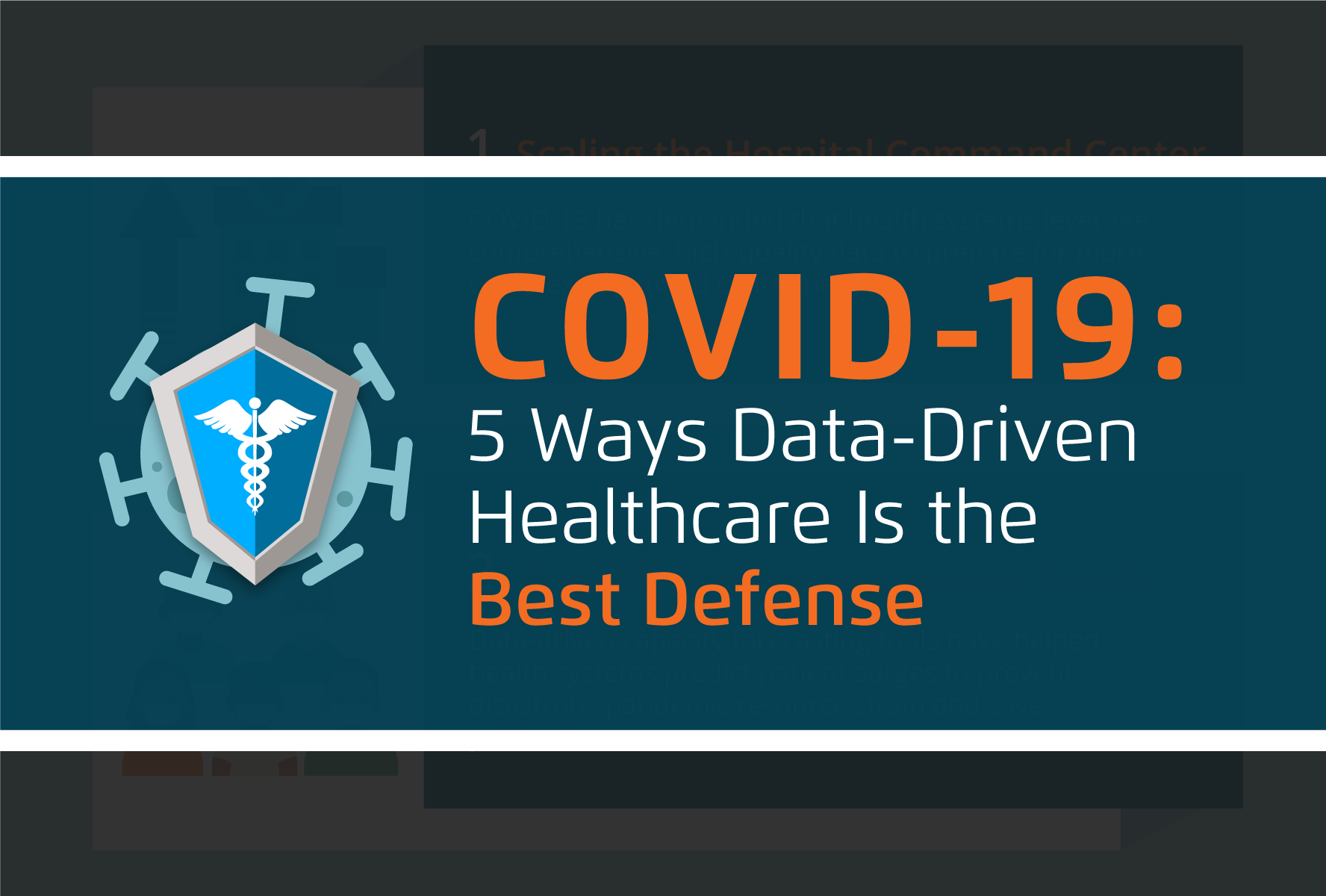COVID-19 has given data-driven healthcare the opportunity to prove its value on the national and global stages. Health systems, researchers, and policymakers have leveraged data to drive critical decisions from short-term emergency response to long-term recovery planning.
Five areas of pandemic response and recovery stand out for their robust use of data and measurable impact on the course of the outbreak and the individuals and frontline providers at its center:
1. Scaling the hospital command center to pandemic proportions.
2. Meeting patient surge demands on hospital capacity.
3. Controlling disease spread.
4. Fueling global research.
5. Responding to financial strain.
 Download
Download

Since COVID-19 became a global focal point in the late winter and early spring of 2020, data has been an indispensable tool in response and recovery, particularly in the healthcare sector. Health systems, researchers, and policymakers have leveraged data to drive critical decisions from short-term emergency response to long-term recovery planning and vaccine studies. Organizations with data-driven cultures and processes to access, manage, and share knowledge have successfully navigated patient surges and resource strains, tempered disease spread, expanded understanding of the virus across healthcare and research communities, mounted effective financial responses, saved patient lives, and more.
While data has supported and improved COVID-19 response and recovery in innumerable ways, five areas stand out for their robust use of data and measurable impact on the course of the outbreak and the individuals and frontline providers most affected:
Hospital command center leaders have never had to run an incident response on the scale of the COVID-19 pandemic. Whereas a typical emergency event (e.g., flooding, earthquakes, multivehicle collisions, or shootings) causes rapid patient influx with an identifiable starting and stopping point, mostly requiring only basic data and analytics for impact forecasting, the novel coronavirus has had an ongoing, inestimable impact on operations. The extensive duration combined with high transmission risks and massive scope of COVID-19 has demanded that health systems prepare for more complex facility, equipment, and staffing needs than leaders and team members have trained in or experienced. Successful organizations have used comprehensive, accurate, and accessible data to scale their response around the areas of highest pandemic impact: clinical capacity, equipment, and staffing.
Health system resource strain became an urgent concern early in the COVID-19 pandemic. Hard-hit areas exhausted their hospital beds, ventilators, personal protective equipment, staffing, and other life-saving essentials, while other regions scrambled to prepare for inevitable surges. These resource concerns heightened the need for accurate, localized, data-informed hospital capacity planning. Capacity forecasting leverages operational, clinical, and population health data to predict a patient surge and its demand on resources. This foresight allows planners to design and implement mitigation strategies that can prevent disastrous pandemic resource strain and save patient lives.
Because COVID-19 appears to spread mainly through respiratory droplets from person-to-person contact (e.g., coughs, sneezes, or speech), knowing where infected patients have been and with whom they’ve been in contact is vital. For health systems, patient and staff contact tracing is one of the top transmission-control and life-saving strategies. With this insight, organizations can manage transmission with data-driven emergency planning and monitoring capabilities. Contact tracing aligns existing patient flow data (from manual tracking) with potential staff exposure indicators from the clinical record, such as which parts of the facility the patient entered and the types of treatments or testing they underwent. This process provides analytic insights surrounding patient movement and interactions between staff and patients with either a confirmed or suspected infection. These data can then encourage informed and timely action.
Incomplete, non-transparent, and out-of-date COVID-19 data has been one of the main barriers to understanding and managing the virus nationally and abroad, as well as developing a vaccine. In addition to driving COVID-19 understanding within the United States, data from a national disease registry informs research beyond U.S. borders. Clinicians with the Singapore Ministry of Healthcare’s (MOH) Office for Healthcare Transformation (MOHT) have used the Health Catalyst Touchstone® COVID-19 Registry and Insights to develop a machine learning tool that helps predict the likelihood of COVID-19 mortality. With this national data set that leverages deep aggregated EHR data, the MOHT accessed the research-grade data needed to build a machine-learning algorithm that predicts the risk of death from COVID-19. The registry-informed prediction model was accurate enough to stand up to comparisons in the published literature and promises to help inform vaccine research and, ultimately, allocation of vaccines within populations.
COVID-19 has made traditional, historical-data financial methodologies obsolete and highlighted the imperative for health systems to create a new, effective financial emergency response. Organizations can get back on the road to financial recovery and well-being and prepare for future obstacles by practicing three key strategies centered around data:
Healthcare’s journey to becoming data driven has often been fraught, with difficulties ranging from sunk costs to clinician burnout and more. With COVID-19, digitization has proven its value on the global stage: data-first organizations have most effectively and safely delivered care while navigating financial strains, while accessible, shareable data has been critical to disease management and prevention research, ultimately saving patient lives.
Would you like to learn more about this topic? Here are some articles we suggest:
PowerPoint Slides
Would you like to use or share these concepts? Download the presentation highlighting the key main points.
Click Here to Download the Slides
https://www.slideshare.net/slideshow/embed_code/key/CovUIXtPxv8Z13